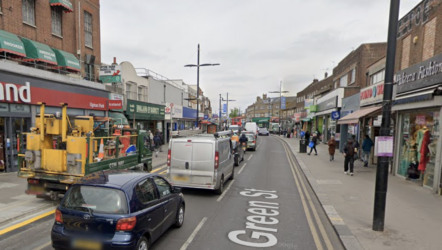Receive free Travel updates
We’ll send you a myFT Daily Digest email rounding up the latest Travel news every morning.
Following an afternoon pounding the pavements of east London, a group of international tourists are taking refuge in a hushed, oak-panelled room on the piano nobile of an 18th-century townhouse. Kathleen Milligan, a Texan in her fifties, has bagged an antique armchair and is navigating a china teacup and saucer and a cake made to a 300-year-old London recipe. “I love the narrow, cobbled streets here in Spitalfields, all these old buildings rammed up against skyscrapers,” she says.
Milligan found The Gentle Author’s Tour of Spitalfields via Instagram when it launched last year, and booked it because it offered a different perspective on London. Spitalfields is shown through the eyes of its residents (the townhouse has been loaned by a supporter to offer a glimpse of Londoners’ lives behind closed doors); the trips are run by a community tourism venture set up by locals in this densely urban part of the East End.
Spitalfields is within the borough of Tower Hamlets, where more than three quarters of residents belong to minority ethnic groups. Tour guides are chosen to reflect the area’s diverse population — of Bangladeshi, Jewish, Somali heritage and more. They show groups of 15 or so visitors around on “a ramble through 2,000 years of culture”, offering a personal view of an area shaped by successive waves of migration.
The Gentle Author’s map of Spitalfields, drawn by Adam Dant
But the initiative also has another aim, to offer “an engaging alternative” to the tours that have grown increasingly dominant in this part of London — those focusing on the murderer who killed five women in this part of the city in 1888. To thousands of tourists each year, the Jack the Ripper walking tours are an entertaining, if ghoulish, way to explore part of the city they may not otherwise visit. Some locals disagree, believing such tours help to create a distorted narrative of the place they call home.
That the killer was never caught still haunts — and titillates — London’s popular memory. But “there is more to Spitalfields than just a place where some disturbed lunatic killed some people over a century ago”, says Paul Godfrey, aka the Gentle Author, a historian, blogger and founder of the community tours.
London is not unique in its offerings of murder-themed entertainment. There are gangster-themed tours in US cities including Las Vegas and New York, Pablo Escobar-themed tours in Colombia, an OJ Simpson tour of Brentwood, Los Angeles (in a Ford Bronco), even a Fritz Haarmann-themed murder tour of Hannover.

Nicholas Hawksmoor’s masterpiece Christ Church, in Commercial Street in Spitalfields © Alamy

And some of the area’s 18th-century Huguenot houses © Alamy
But in London’s East End, murder tours have become dense. One offers “state of the art Ripper-Vision™” projections that promise to recreate Victorian London. Another investigation-style trip provides the chance to join Victorian detectives “step by blood-curdling step”.
Hallie Rubenhold, an American historian, author and broadcaster whose 2019 book The Five sought to draw out the humanity of the Ripper’s victims, points out that Ripper tours have been around almost since the days of the murders. “People came from the West End of London to be shown around where they happened,” she says. “There has been gruesome tourism here since 1888 and it’s not about to stop now — but it can be done sensitively and intelligently, rather than revelling in gore.”
The Gentle Author’s tours start and finish on the steps at Christ Church, Nicholas Hawksmoor’s masterpiece of English baroque, completed in 1729. They vary depending on the guides, who include a playwright and anti-racism activist, and a restaurant insider who shares stories of Brick Lane’s curry house trade.
Most of the tours include the ornate Edwardian Soup Kitchen for the Jewish Poor on Brune Street, the site of a Roman cemetery on Bishopsgate and a chain of mosques, synagogues, pubs, alleyways, music halls and industrial infrastructure — many of them repurposed over generations.
Oral histories, personal testimonies and readings attempt to lend voice to Spitalfields residents over millennia, such as Aemilia Lanyer, often seen as England’s first professional female poet and possibly Shakespeare’s “Dark Lady”. And Suresh Singh, the “first Punjabi punk” musician, who played drums with Spizzenergi in the 1970s.
Most affecting is the story of Bedford House, a slab of Victoriana on the corner of Quaker and Wheeler Streets, built as a mission to support poor residents. In 1900, a local photographer, Horace Warner, took a series of photographs of the children who used the mission, in what became known as the “Spitalfields Nippers” portraits.

An issue of the Illustrated Police News from September 1888 depicts Jack the Ripper’s fourth murder © Alamy
On the tour I took, Godfrey described how one in five Victorian children in London did not survive into adulthood. Warner’s portraits were passed around, and the children’s life stories read out. Some died young; others lived and thrived until the 1970s and 1980s, well within living memory. Survival seemed horribly arbitrary. “Poverty did not define all Spitalfields lives,” says Godfrey. It’s a little earnest maybe, but the crowd of mostly Americans is enthralled.
Milligan says she booked a Ripper tour once. It was fine, but “most of the places are gone. It was like, here’s a giant skyscraper where a murder happened.” She might consider another one but thinks anglophiles would also do well to give London’s more complex, multicultural histories a try.
The Gentle Author’s Tours of Spitalfields (thegentleauthorstours.com) last about two hours and cost £40
https://www.ft.com/content/50dff765-36bd-4d96-9b51-704cf0bcdc84





